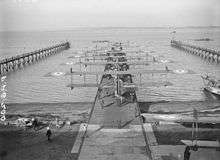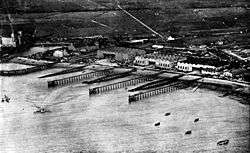Seaplane Experimental Station
| Seaplane Experimental Station | |
|---|---|
| Felixstowe, Suffolk | |
|
Sheds and slipways | |
| Coordinates | 51°56′42″N 1°19′16″E / 51.945°N 1.321°E |
| Type |
Naval air station Royal Air Force station |
| Site information | |
| Controlled by |
|
| Site history | |
| In use | August 1913-June 1919 |
| Battles/wars | First World War |
The Seaplane Experimental Station, formerly RNAS Felixstowe was a British aircraft design unit during the early part of the 20th century.
Creation
The unit at Felixstowe was commissioned 5 August 1913 under the command of Captain C. E. Risk, RM as Seaplanes, Felixstowe followed by Lieutenant C. E. H. Rathborne, RN in 1914 and Lieutenant-Commander John Cyril Porte, RN 1915.
RNAS Felixstowe was created soon after the outbreak of World War I following the formation of the Royal Naval Air Service 1 July 1914.
Operation

As the name implies, the unit designed seaplanes and flying boats. These were generally known by the Felixstowe name although, apart from the prototypes, these flying boats were built by aircraft manufacturers such as Short Brothers, Dick, Kerr & Co. and Phoenix Dynamo Manufacturing Company (the latter two forming part of English Electric in 1918–1919).
Upon Porte's recommendation, the station was initially equipped with Curtiss flying boats. He improved their hull designs, before developing the Felixstowe flying boats from those experiments. Many Felixstowe boats were built under licence in the USA. The craft were flown on long-range patrols to spot the German High Seas Fleet and Zeppelins, with many based at RNAS Felixstowe.
In 1916 they ran trials in conjunction with the Submarine Service at Parkeston Quay to test the carriage and launching of seaplanes carried on the deck of submarine E22.[1]
On formation of the Royal Air Force 1 April 1918, the unit was renamed the Seaplane Experimental Station, Felixstowe and disbanded in June 1919.
Successor
The base and its facilities were later used by the Marine Aircraft Experimental Establishment from 1 April 1924 until the Second World War. It was also used as a base by the Schneider Trophy team, the High Speed Flight. RAF Felixstowe closed 21 June 1962.
Designs
- Felixstowe Porte Baby
- Felixstowe F.1
- Felixstowe F.2
- Felixstowe F.3
- Felixstowe F.5
- Felixstowe F5L
- Felixstowe Fury
Station commanders
- Captain C. E. Risk, RM 1913–1914
- Lieutenant C. E. H. Rathborne, RN 1914–1915
- Commander J. C. Porte, RN 1915–1918
- Wing Commander C. E. Risk, RAF 1918–1919
- Wing Commander I. T. Courtney, RAF 1919–1922
- Flying Officer F. Wilton, RAF 1922–1924
- Wing Commander C. E. H. Rathborne, RAF 1924–1925
- Wing Commander R. B. Maycock, RAF 1925–1928
- Group Captain G. R. Bromet, RAF 1928–1931
- Group Captain A. J. Milley, RAF 1931–1936
- Group Captain E. J. P. Burling, RAF 1936–1939
- Wing Commander D. G. Fleming, RAF 1939–1940
- Wing Commander W. B. Hellard, RAF 1940–1942
- Wing Commander N. Keeble, RAF 1942–1943
- Wing Commander L. G. Martin, RAF 1943–1945
- Group Captain W. G. Abrams, RAF 1945–1946
- Group Captain W. P. Welch, RAF 1946–1948
- Group Captain C. A. Watt, RAF 1948–1949
- Wing Commander D. H. Thomas, RAF 1949–1951
- Wing Commander C. V. Winn, RAF 1951–1953
- Wing Commander J. A. Chorlton, RAF 1953–1954
- Wing Commander W. O. Jones, RAF 1954–1956
- Wing Commander R. P. Burton, RAF 1956–1957
- Wing Commander J. T. O'Sullivan, RAF 1957–1960
- Wing Commander C. F. Price, RAF 1960–1961
- Wing Commander C. H. Baker, RAF 1961–1962[2]
See also
- RAF Coastal Area
- Aeroplane & Armament Experimental Establishment at Martlesham Heath
- Marine Aircraft Experimental Establishment
References
- ↑ Paul Akermann, Encyclopedia of British Submarines 1901–1955
- ↑ "365 (Felixstowe) Squadron Air Training Corps". RAF Felixstowe - Station Commanders. Royal Air Force, 356 (Felixstowe) Squadron Headquarters, Carr Road, Felixstowe Suffolk IP11 3RX United Kingdom. Retrieved 2 September 2013.
External links
- Photographs taken at Felixstowe and Lowerstoft 1914–1918 on YouTube
- Our Naval Power (Reel 4) Film of Curtiss and Felixstowe flying boats at Felixstowe, an aerial view of the base and a convoy at sea, 1917–1918.
- Sons of Our Empire: Film of the Royal Naval Air Service at Felixstowe taken after the Battle of Jutland, including John Cyril Porte studying a map with some other officers, Curtiss H-2 and prototype Felixstowe F.1 (No. 3580) fitted with Anzani engines, Flight Commander Porte and Commodore George C. Cayley RN returning from a flight in a Felixstowe F.1; Porte, Cayley and Commander Hubert Lynes RN together in front of a Short Type 184 seaplane, 1916.
- Naval aviation on YouTube Film of Porte with Cayley and Lynes as above and other scenes of flying boats at RNAS Felixstowe, including an Anzani engined Curtiss H-4 taxiing, Felixstowe F.2A moved down a slipway on its beaching trolley and H-12 Large Americas being launched, one loaded with bombs, c.1917.
- Seaplanes Film of Short and Fairey seaplanes including the Short 310 and Fairey N.9; scenes of Felixstowe flying boats at Felixstowe, 1918.
- Felixstowe Sports Film of an athletics meeting for RAF and Royal Navy personnel at the Seaplane Experimental Station, 13 August 1918.
- Lt. Wendell Phillipo Loomis Documents and photographs
- Seaplanes Film of Short and Fairey seaplanes; scenes of Felixstowe flying boats at Felixstowe, 12 November 1918.
- Felixstowe, Suffolk: Pioneering Sea Plane Base Audio recording of George Edward Brice who recalls naval aviator Charles Rumney Samson testing a seaplane during World War One.
